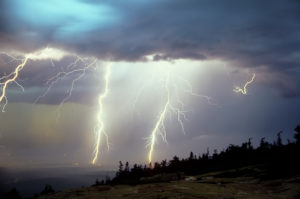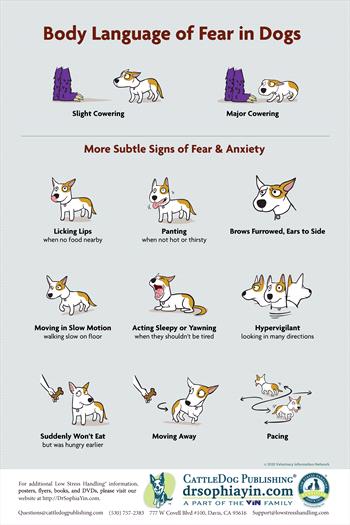It is April, and thunderstorms are upon us here in the Midwest. Many dogs are fearful of thunderstorms. It is the most common subtype of noise phobias in dogs. The behavioral response may vary from mild pacing or panting up to escape behaviors such as digging repetitively at the door, trembling severely, or injuring teeth and nails to get out of confinement. Triggers for the fear include falling barometric pressure, wind, rain, cloud cover, and thunder (1) Many of these triggers are present hours before the storm develops. When the thunder and lightening occur, often the dog escalates into full panic due to the build up of anxiety. The impact on the physical health of a dog is significant when they are in a fearful state during a storm. I have seen many a dog with broken teeth from trying to chew their way out of a crate or jump out of a window breaking a leg trying to escape the storm. Fortunately, there is a myriad of pheromones, supplements, medications, safety plans, and tools to help reduce the panic response in dogs. In my 35 years of practice, I have found a way to quickly screen for storm anxiety, provide the medical plan based on the screening tool and a simple safety plan to reduce storm fear. I call this the Storm Sangria. It is one of the behavior cocktails you will learn about in my webinar Behavior Cocktails.
A few things to note are the Behavior Cocktails are not behavior consult, or only medication plans. These are intervention plans using the medication, supplement, pheromone or tool combined with a simple behavior modification plan based on my clinical experience in general practice. These cocktails are designed to give a simple plan combining the most effective and safe medication with behavior modification plan when your client says “ Oh by the way …” at the end of an exam and you do not have the time for a consult. You also, do not want the problem to get worse. Like an intervention plan for a medical problem, this is a starting point to prevent escalation of the problem. The client’s commitment to this plan, and response to the plan will be reviewed by your lay staff ( again a time saver) from which you decide if this is a case for a full consult.
First some of the main points to know about storm and noise phobia:
- This problem may have been brewing for years and has built up to a point of panic. A plan that has both the correct medications to bring the fear level below the point of eating food combined with the dog going to a safe room, which blocks the triggers to fear is the key to improving behavior. When you have this plan in place, many dogs can reduce fear significantly in the first season, and then need less medication for subsequent seasons.
- Some dogs may suddenly be fearful due to a past intense storm event. They will not “ get over it” they need meds and a plan now!
- Recognizing the early signs of anxiety to be sure the plan is being followed is imperative. Often clients wait until the dog has been nervous for hours before giving medications, putting them in a quiet area. The storm rolls in before the meds are working, and the dog is scared in the quiet room, not calm.
- Triggers can be the wind, rain, thunder, lightning, change in barometric pressure, so isolate them from that. Also, brain aging, experience or other health issues can aggravate noise phobia.
For an intervention plan, the focus is easy ways to train the dog to go to the safe room, match the amount of medication to the most panicked a dog gets during a storm, and providing a safe room space that blocks out the triggers of wind, thunder, rain and lightning. You can create some of the handouts I describe below. Hand out packets are included with the webinar for your use.
Here are the main points of the Storm Sangria:
- Screen for the level of panic during storms. Use the storm report card or create your own short survey for the client to fill out.
- All dogs learn to go to a safe room ( bathroom, basement or walk in closet, or crate) – on non-storm days use the meal to toss and make it a fun game to go in there and hunt around for the food. Keep a stuffed Kong in the freezer to last a long time as a reward in the safe room.
- Play heavy beat, deep in the base rock music to provide the filter for the triggering noises
- Frozen food in a Kong or other easy food puzzle.
- According to the storm report card, use the Pheromone, supplement or medication to provide a calm dog for the duration of the storm. In the cocktail plan, all dogs at level 2 ( low level anxiety) wear an adaptil collar. Level 3 –( moderate level anxiety) add Propranolol. Level 4 – high anxiety, panic add Diazepam. Use the Storm Sangria Check list to create your cocktail and give to your client.
For older dogs, consider the need to screen and treat for arthritis or cognitive dysfunction syndrome. The older dog Sangria cocktail of Zylkene and Adaptil collar is safe and effective.
There are many anxiety reducing medications to choose from to help a dog during a storm. So how does a DVM choose? In my experience, as an intervention plan medication need to be safe, last at least 8 hours as most of my clients work. The Adaptil collar is a baseline anxiety reducing pheromone that helps in low level anxiety and helps synergize the calming effect of other medications. Propranolol is an older medication that decreases the physical symptoms of anxiety – high heart rate, muscle tremors, and in humans decreases the effect of ptsd. This medication was recommended by Dr Wayne Hunthausen DVM years ago and has served my clients well. The medication lasts 8-12 hours, is not sedating and safe to give in anticipation of a storm. Adding in Diazepam for the highly anxious, panicked dog provides 8 – 12 hours of mild sedation, and rest. Other medications such as Sileo, Alprazolam, or Clonidine can work well yet they last a few hours.
Aging dogs can be worse or better with storms. For dogs over 10 who are now showing storm fear, follow the safe room plan and use non drug therapies with pain relief medications. Many of the supplements help reduce cognitive dysfunction, which is often the cause for the worsening anxiety coupled with the inability to get up and go to a safe room. An NSAID enables the dog to get to the safe room, as the Adaptil and Zylkene provide mental calming that is safe on an aging body.
In my experience, rhythmic music, heavy in the base calms better than classical music. After attending a presentation on noise phobias discussing rock type music, I played North African Belly dancing music for my dog Butterscotch during a storm. The music and his Adaptil collar had him asleep within the first minute. Client feedback is how Butterscotch’s play list was created.
Food puzzles are helpful to give a dog in the safe room during storm. Stocking the freezer with a few Kong’s stuffed with canned dog food makes it easy to toss in the room, and long lasting if the storms roll on for hours. Use food puzzles that do not have parts that can be eaten and are not too difficult for the dog to engage in.
Teach your dog to go to the bathroom or basement readily by using the learn to earn as a game. Reward your dog as you approach the bathroom, or basement, then quickly toss food in the room and out to make it a fun game to go in there and stay in there. You can see my YouTube videos demonstrating a storm safety plan here:
Get in the bathroom https://www.youtube.com/watch?v=YOia4yajy6M
Get in the basement https://www.youtube.com/watch?v=bwwA0UKDIOY





